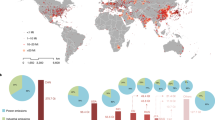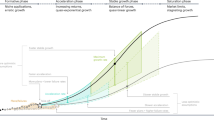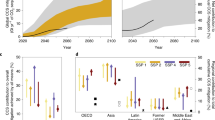Abstract
To offset the cost associated with CO2 capture and storage (CCS), there is growing interest in finding commercially viable end-use opportunities for the captured CO2. In this Perspective, we discuss the potential contribution of carbon capture and utilization (CCU). Owing to the scale and rate of CO2 production compared to that of utilization allowing long-term sequestration, it is highly improbable the chemical conversion of CO2 will account for more than 1% of the mitigation challenge, and even a scaled-up enhanced oil recovery (EOR)-CCS industry will likely only account for 4–8%. Therefore, whilst CO2-EOR may be an important economic incentive for some early CCS projects, CCU may prove to be a costly distraction, financially and politically, from the real task of mitigation.
This is a preview of subscription content, access via your institution
Access options
Access Nature and 54 other Nature Portfolio journals
Get Nature+, our best-value online-access subscription
$29.99 / 30 days
cancel any time
Subscribe to this journal
Receive 12 print issues and online access
$209.00 per year
only $17.42 per issue
Buy this article
- Purchase on SpringerLink
- Instant access to full article PDF
Prices may be subject to local taxes which are calculated during checkout




Similar content being viewed by others
References
IPCC Climate Change 2014: Mitigation of Climate Change (eds Edenhofer, O. et al.) (Cambridge Univ. Press, 2014).
BP Statistical Review of World Energy June 2015 (BP, 2015).
Energy Technology Perspectives 2014—Harnessing Electricity's Potential (IEA, 2014).
World Energy Investment Outlook 2014 Factsheet (IEA, 2014).
Jaccard, M. Sustainable Fossil Fuels: The Unusual Suspect in the Quest for Clean and Enduring Energy (Cambridge Univ. Press, 2006).
Brown, J. A. G., Eickhoff, C. & Hanstock, D. J. Capacity and Balancing Options for the Design of Power Plant in the UK (Institution of Chemical Engineers, 2014); http://go.nature.com/2lTDsAF
Mac Dowell, N. et al. An overview of CO2 capture technologies. Energy Environ. Sci. 3, 1645–1669 (2010).
Boot-Handford, M. E. et al. Carbon capture and storage update. Energy Environ. Sci. 7, 130–189 (2014).
IPCC IPCC Special Report on Carbon Dioxide Capture and Storage (eds Metz, B. et al.) (Cambridge Univ. Press, 2005).
Rochelle, G. T. Amine scrubbing for CO2 capture. Science 325, 1652–1654 (2009).
Wallace, M. & Kuuskraa, V. Near-Term Projections of CO2 Utilization for Enhanced Oil Recovery (NETL, 2014).
Godec, M. L. Global Technolgogy Roadmap for CCS in Industry: Sectoral Assessment CO2 Enhanced Oil Recovery (United Nations Industrial Development Organisation, 2011).
Dooley, J. J. et al. Carbon Dioxide Capture and Geologic Storage (Global Energy Technology Strategy Program, 2006).
Blunt, M. Carbon Dioxide Storage. Briefing Paper No. 4 (Grantham Institute for Climate Change, 2010).
CO2 Capture and Storage: A Key Carbon Abatement Option (IEA, 2008).
Gale, J. Geological storage of CO2: what's known, where are the gaps, and what more needs to be done? Greenhouse Gas Control Technol. 1, 201–206 (2003).
Technology Roadmap: Carbon Capture and Storage (IEA, 2013).
The Global Status of CCS: 2015 (Global CCS Institute, 2015).
Driven by China, Global Methanol Demand to Rise Nearly 80 Percent by 2023; North America Marks Return as “Production Powerhouse”. IHS (29 August 2014).
The World Factbook (CIA, accessed 18 August 2014); http://go.nature.com/2mbQZ7T
Key World Energy Statistics (IEA, 2012).
Energy Technology Perspectives 2012—How to Secure a Clean Energy Future (IEA, 2012).
Heuberger, C. et al. Quantifying the value of CCS for the future electricity system. Energy Environ. Sci. 9, 2497–2510 (2016).
Dai, Z. et al. CO2 accounting and risk analysis for CO2 sequestration at enhanced oil recovery sites. Environ. Sci. Technol. 50, 7546–7554 (2016).
Dai, Z. et al. An integrated framework for optimizing CO2 sequestration and enhanced oil recovery. Environ. Sci. Technol. Lett. 1, 49–54 (2014).
Charles, D. Stimulus gives DOE billions for carbon-capture projects. Science 323, 1158 (2009).
Vora, S. D. DOE/NETL Advanced Carbon Dioxide Capture R&D Program: Technology Update (National Energy Technology Laboratory, 2013).
Optimisation of CO2 Storage in CO2 Enhanced Oil Recovery Projects (Advanced Resources International, 2010).
GHG Equivalencies Calculator—Calculations and References (EPA, 2016).
Lipponen, J. Storing CO2 Through Enhanced Oil Recovery: Combining EOR with CO2 Storage (EOR+) For Profit (IEA, 2015).
Mui, S. et al. GHG Emission Factors for High Carbon Intensity Crude Oils (Natural Resources Defense Council, 2010).
Inoue, S., Koinuma, H. & Tsuruta, T. Copolymerization of carbon dioxide and epoxide. J. Polymer Sci. B Polymer Lett. 7, 287–292 (1969).
Song, C. Global challenges and strategies for control, conversion and utilization of CO2 for sustainable development involving energy, catalysis, adsorption and chemical processing. Catal. Today 115, 2–32 (2006).
Song, C. In CO2 Conversion and Utilization (eds Song, C. et al.) 2–30 (ACS, 2002).
Aresta, M., Dibenedettoa, A. & Angeini, A. The changing paradigm in CO2 utilization. J. CO2 Utilization 3–4, 65–73 (2013).
Kolbe, H. & Lautemann, E. Über die Constitution und Basicität der Salicylsäure. Ann. Chem. 113, 125–127 (1869).
Solvay, E. Absorption of ammonia in soda ash production. US patent 263,981 A (1882).
Bosch, C. & Meiser, W. Process of manufacturing urea. US patent 1,429,483 A (1922).
Department, B. World chemical outlook 2017. Chem. Eng. News 91, 11–19 (2013).
Kirchofer, A., Brandt, A., Krevor, S., Prigiobbe, V. & Wilcox, J. Impact of alkalinity sources on the life-cycle efficiency of mineral carbonation technologies. Energy Environ. Sci. 5, 8631–8641 (2012).
Olah, G. A., Goeppert, A. & Surya Prakash, G. K. Beyond Oil and Gas: The Methanol Economy. (Wiley, 2009).
Van-Dal, E. S. & Bouallou, C. Design and simulation of a methanol production plant from CO2 hydrogenation. J. Cleaner Prod. 57, 38–45 (2013).
Hall, C., Balogh, S. & Murphy, D. What is the minimum EROI that a sustainable society must have? Energies 2, 25–47 (2009).
Hall, C. A. S., Lambert, J. G. & Balogh, S. B. EROI of different fuels and the implications for society. Energy Policy 64, 141–152 (2014).
Dale, M., Krumdieck, S. & Bodger, P. Global energy modeling: a biophysical approach (GEMBA) part 1: an overview of biophysical economics. Ecol. Econ. 73, 152–157 (2012).
Kubiszewski, I., Cleveland, C. & Endres, P. Meta-analysis of net energy return for wind power systems. Renew. Energy 36, 218–225 (2010).
Rubin, E. S. et al. Use of experience curves to estimate the future cost of power plants with CO2 capture. Int. J. Greenhouse Gas Control 1, 188–197 (2007).
van den Broek, M. et al. Effects of technological learning on future cost and performance of power plants with CO2 capture. Prog. Energy Combustion Sci. 35, 457–480 (2009).
Author information
Authors and Affiliations
Contributions
All authors contributed to the planning of the paper. N.M.D. led the work, benefiting from discussions with all authors. All authors contributed to writing the paper, providing comments to the framework, and input in terms of numbers and references backing the analysis.
Corresponding author
Ethics declarations
Competing interests
The authors declare no competing financial interests.
Rights and permissions
About this article
Cite this article
Mac Dowell, N., Fennell, P., Shah, N. et al. The role of CO2 capture and utilization in mitigating climate change. Nature Clim Change 7, 243–249 (2017). https://doi.org/10.1038/nclimate3231
Received:
Accepted:
Published:
Issue Date:
DOI: https://doi.org/10.1038/nclimate3231
This article is cited by
-
Biological CO2 Utilization; Current Status, Challenges, and Future Directions for Photosynthetic and Non-photosynthetic Route
Arabian Journal for Science and Engineering (2025)
-
The importance of porewater exchange process on carbon lateral export from saltmarsh creek to coastal sea
Journal of Oceanology and Limnology (2025)
-
Recent progress in electrocatalytic C-N coupling of CO2 and inorganic N-containing small molecules
Science China Chemistry (2025)
-
Geochemical interactions of supercritical CO2-brine-rock under varying injection strategies: implications for mechanical integrity in aquifers
Rock Mechanics and Rock Engineering (2025)
-
Sustainable thermal buffering of microencapsulated bio-phase change materials through an engineered biochar dopant
Biochar (2025)



